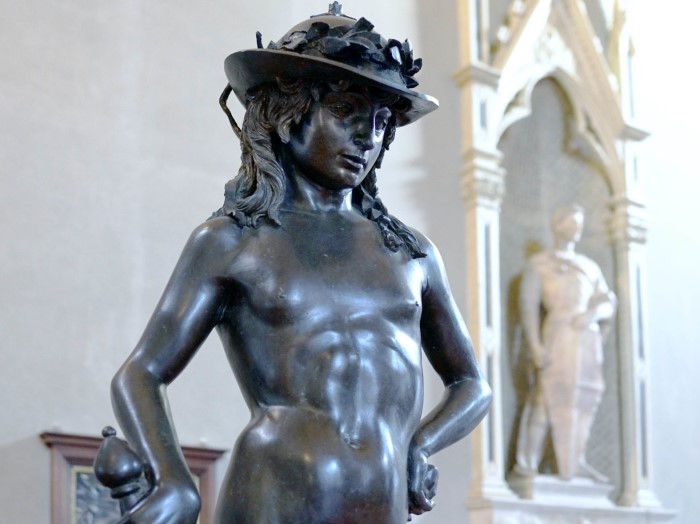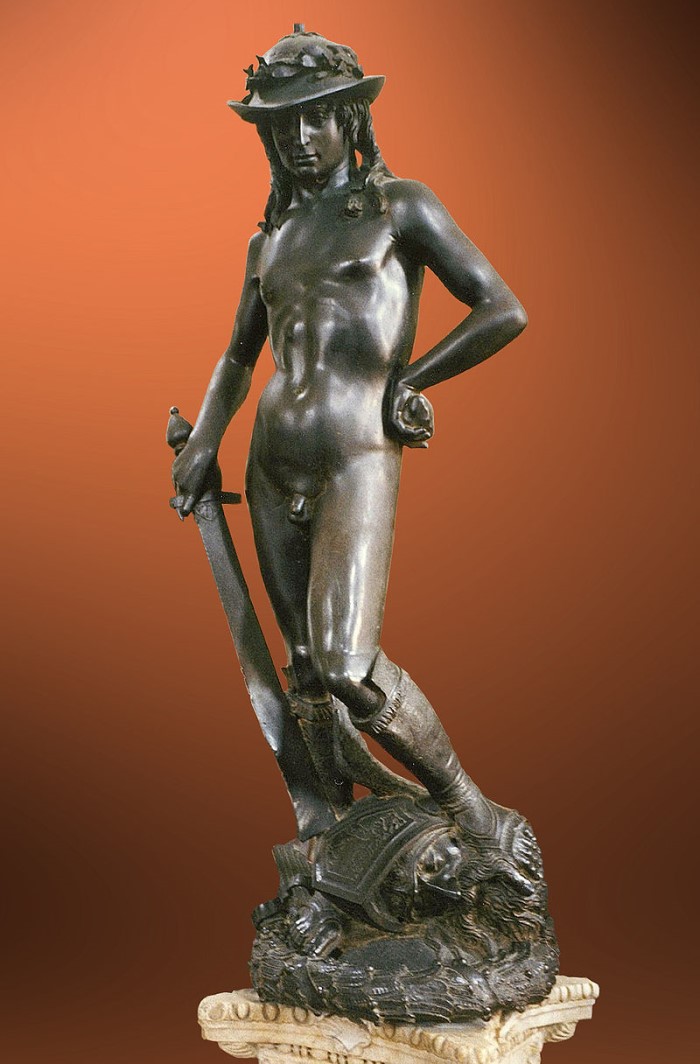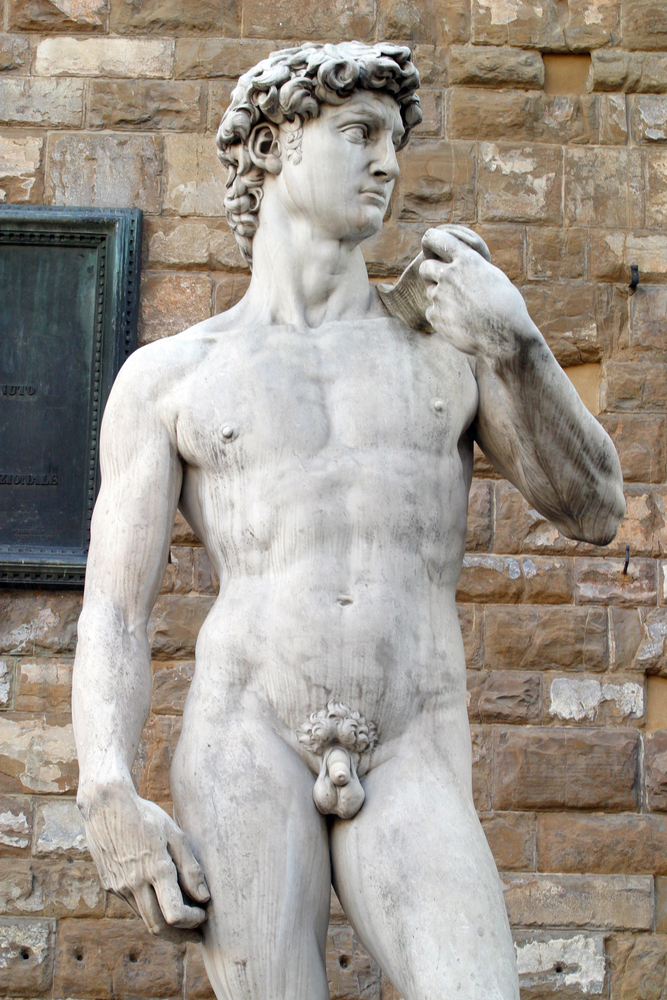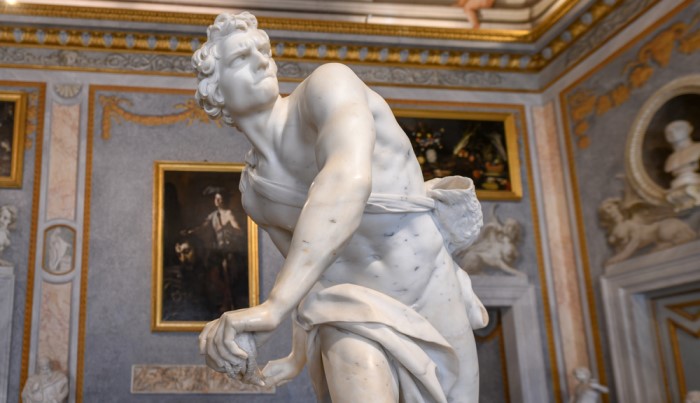
Examining two sculptures by two distinct artists who created pieces based on the same subject during the Renaissance provides us with an opportunity to appreciate the distinct style of sculpture during this era. Taking a look at these works from the fifteenth and sixteenth centuries, it's obvious that this is a process. The sculptures depict the story of David and the battle with Goliath, showcasing the concept of the little guy versus the bully and David's demonstration of humility while fighting the arrogance of Goliath.
For the people of the Renaissance, David symbolized courage, leadership, and faithfulness - he was a representation of Jesus and a model for believers. Fortunately, we can observe how this tale has been interpreted in three separate artworks, and this is what we shall do in this article.

Donatello's David
Donatello's David, created between 1424-1430, is housed in the Bargello Museum in Florence and is a life-sized bronze statue. This artwork stands as a testament to Italian sculpture in the 15th century. The representation of David after the battle is of a nude man, which viewers can observe from every angle. This is a renewal of classical origins, a remarkable breakaway during the Middle Ages since nudity was not something that was seen in classical Greece. Donatello's uncle is portrayed as a classical hero, comparable to the ancient Greek statues. This trend of reviving antiquity is visible with the elements used here - free sculpture, chaotic standing, nude, bronze - making Donatello's David an exciting piece of art!
Michelangelo's David
Donatello's sculpture of David presents a "true-to-life" representation of an adolescent boy. The figure is a combination of classical elements and those extracted from a live model: the chest is narrow, the shape is dainty, and the posture is sensuous and seductive (in the style of ancient Greek art). The statue is made by following the structure of diagonals and includes the Gothic s-curve. Viewers can see the young lad's gorgeousness and courage. There is a plume delicately touching David's leg, stretching from the helmet to his foot, adding a further layer of seductiveness to the piece. Additionally, the hat and boots give the sculpture a mysterious and alluring quality that incites curiosity and voyeurism.

Michelangelo's David stands approximately 4 meters tall, is crafted from marble and is displayed in the Academy Gallery in Florence. This statue represents the 16th century, with its symbol of strength and power. In a state of introspection and contemplation, David is portrayed as ready for battle with Goliath. His image stands for greatness, beauty, courage, and wisdom. The sculpture is frontal and peaceful, and viewers are invited to share in David's psychological state of fear and anticipation of the upcoming fight. The sculpture is a demonstration of the mature Renaissance era and its approach to idealistic art.

The body serves as a kind of container that maintains the tension. David's countenance and his whole body present this feeling, with his facial expressions providing a vivid illustration of the contemplative, idealistic character. As he strides through space, the spectator is drawn in. He looks to be deep in thought and gazing at something far away, yet there is a certain psychological detachment - we share the same state of mind, but we remain distant. To appreciate the artwork, the viewer needs to move around and observe it from all sides, unlike other pieces where all the information can be obtained just by looking at it.

How are they similar?
Comparing Donatello's David and Michelangelo's David reveals some fascinating parallels: both exemplify the reemergence of classical art and a more refined depiction of reality. There are, however, some differences in the pieces; one showcases a more muscular figure while the other has less defined muscles. Additionally, the two sculptures have different expressions - Donatello's is dreamy while Michelangelo's is more focused. This contrast was a deliberate decision by the creators, as Donatello's David is meant to portray him after the battle, with a somewhat relaxed body, while Michelangelo's is meant to illustrate him before the battle, with a stance that symbolizes his readiness. It's truly exciting to observe these distinctions!
What happens to the viewer in each of the works?
Donatello's David was intended to be seen from the front as if it were a relief. There was no finishing on the back of the statue. Michelangelo's David, however, was different. It stirred a sense of restlessness among viewers as if the statue was about to move and was focused on something beyond the frame. Michelangelo expected the viewer to move around the statue and its back was taken into account. It has now become a classic and heavily impacted the culture. Levi's advertisement used the beauty of the statue to create an ideal of masculinity, as well as its product.
The third David

I would be remiss if I didn't add that there was indeed, in 1623, a third David. The renowned sculptor Gian Lorenzo Bernini created 'David' out of marble and it is currently housed in the Borghese Gallery in Rome. This work of art is a representation of the Italian sculpture style of the 17th century. It depicts the exciting moment when David is about to hurl a stone at Goliath, even though the chalice is not visible (unlike Donatello's rendition). The fervor and anticipation of the act are evident in the character's posture, as he twists and contorts his body. An imaginative viewer can easily envision the sequence of events.